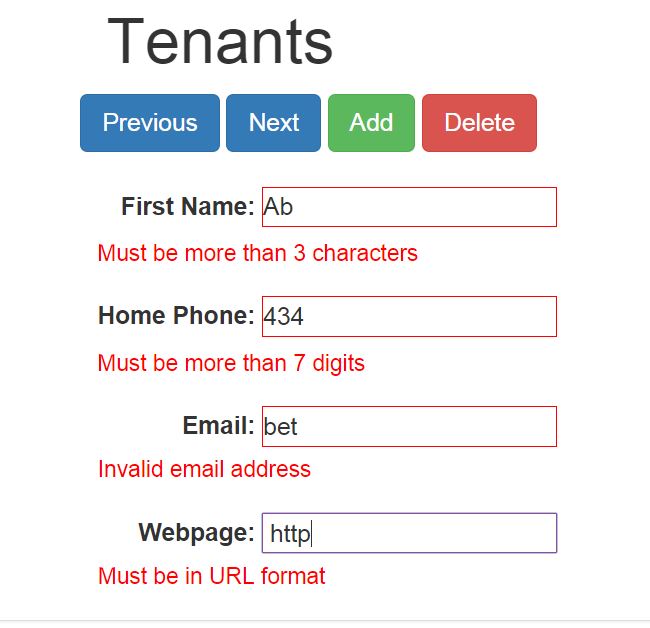I have put a live preview available here:
Also, if you don't want to download source from CodeProject, you can go to my github page:
Introduction
Previously, I wrote a tip about validation in AngularJS. You can find the article here:
But one of the comments wanted a version using AngularJS ng-message directive. I will use my original version application but rewrite it to use ng-message instead of ng-show. For this to work, we have to include an AngularJS module called angular-messages.js. You can view the descript and download the source code here:
Background
Validation was always difficult in a web application. Many times, frameworks need to be used for validating form values. Also, these frameworks often don't work across all browsers. AngularJS comes with validation built in so now it's much easier to create validation that works across browsers.
Here is a screen shot of what the validation feature is supposed to look like:

Using the Code
Using angular-message
To use angular-message, you have to inject into your app module like this:
angular.module("realestateApp", ["ngMessages"]);
Now ng-message will be available to you to use.
Form
To initialize the validation process, you should start with a form container like this:
<form name="tenantForm">
Now inside the form, you can take input controls and add validation logic to them.
In validation scenarios, we typically have a few main attributes we would like to validate. They are Required, Minimum, Maximum, Pattern, Email, Number, and URL.
Required
This attribute forces the form to be invalid if a required field is not entered.
<input type="text" required />
Minimum Length
This attribute requires a minimum of characters before input can be accepted.
<input type="text" ng-minlength=5 />
Maximum Length
This attribute allows a maximum length of character or validation will fail.
<input type="text" ng-maxlength=20 />
Pattern Matching
This feature allows for custom matching using Regex.
<input type="text" ng-pattern="[a-zA-Z]" />
Email Matching
Angular provides a custom email matching feature.
<input type="email" name="email" ng-model="user.email" />
Number
This requires input to be numeric format before validation.
<input type="number" name="age" ng-model="user.age" />
URL
This requires input to be in a link format before validation.
<input type="url" name="homepage" ng-model="user.url" />
Error Messages
Previously, we are using error-container, but now we can just use ng-message directive:
<div ng-messages="tenantForm.Email.$error"
ng-messages-include="messages.html" class="errors"></div>
We also need a messages.html file to store your error messages:
<div class="messages">
<div ng-message="required">Required</div>
<div ng-message="minlength">Too short</div>
<div ng-message="maxlength">Too long</div>
<div ng-message="email">Invalid email address</div>
<div ng-message="compareTo">Must match the previous entry</div>
<div ng-message="number">Must be a number</div>
<div ng-message="url">Must be in URL format</div>
</div>
Error Messages Override
Sometimes, you need to have custom error messages not covered in messages.html. You can do this by adding a special span tag for any custom error message you want to display:
<div ng-messages="tenantForm.FirstName.$error"
ng-messages-include="messages.html" class="errors">
<span class="messages"
ng-message="minlength">Must be more than 3 characters</span>
<span class="messages"
ng-message="maxlength">Must be more than 20 characters</span>
</div>
Putting It All Together
Now we can combine messages.html with index.html.
<form name="tenantForm" novalidate style="width: 500px">
<div class="row">
<div ng-repeat="tenant in tenant">
<div class="form-group">
<label>First Name: </label>
<input type="text"
placeholder="First Name"
name="FirstName"
ng-model="tenant.FirstName"
ng-minlength=3
ng-maxlength=20 required />
<div ng-messages="tenantForm.FirstName.$error"
ng-messages-include="messages.html" class="errors">
<span class="messages"
ng-message="minlength">Must be more than 3 characters</span>
<span class="messages"
ng-message="maxlength">Must be more than 20 characters</span>
</div>
</div>
<div class="form-group">
<label>Home Phone: </label>
<input type="number"
placeholder="Phone Number"
name="HomePhone"
ng-model="tenant.HomePhone"
ng-minlength=7
ng-maxlength=10 required />
<div ng-messages="tenantForm.HomePhone.$error"
ng-messages-include="messages.html" class="errors">
<span class="messages"
ng-message="minlength">Must be more than 7 digits</span>
<span class="messages"
ng-message="maxlength">Must be less than 11 digits</span>
</div>
</div>
<div class="form-group">
<label>Email: </label>
<input type="email"
placeholder="Email"
name="Email"
ng-model="tenant.Email"
required />
<div ng-messages="tenantForm.Email.$error"
ng-messages-include="messages.html" class="errors"></div>
</div>
<div class="form-group">
<label>Webpage: </label>
<input type="url"
placeholder="Webpage"
name="Webpage"
ng-model="tenant.Webpage"
required />
<div ng-messages="tenantForm.Webpage.$error"
ng-messages-include="messages.html" class="errors">
</div>
</div>
</div>
</div>
</form>
<div class="messages">
<div ng-message="required">Required</div>
<div ng-message="minlength">Too short</div>
<div ng-message="maxlength">Too long</div>
<div ng-message="email">Invalid email address</div>
<div ng-message="compareTo">Must match the previous entry</div>
<div ng-message="number">Must be a number</div>
<div ng-message="url">Must be in URL format</div>
</div>
This approach feels cleaner than using ng-show directive. Also, it reduces code duplication by having a central place to store your error messages but at the same time allows for custom messages.
In my next article, I will talk about having a central location to store validation logic for ease of maintenance. Also, I would like to add internationalization for error messages in multiple languages.
Thanks for reading.
History
- Version 1 5/18/2015 Created first draft
